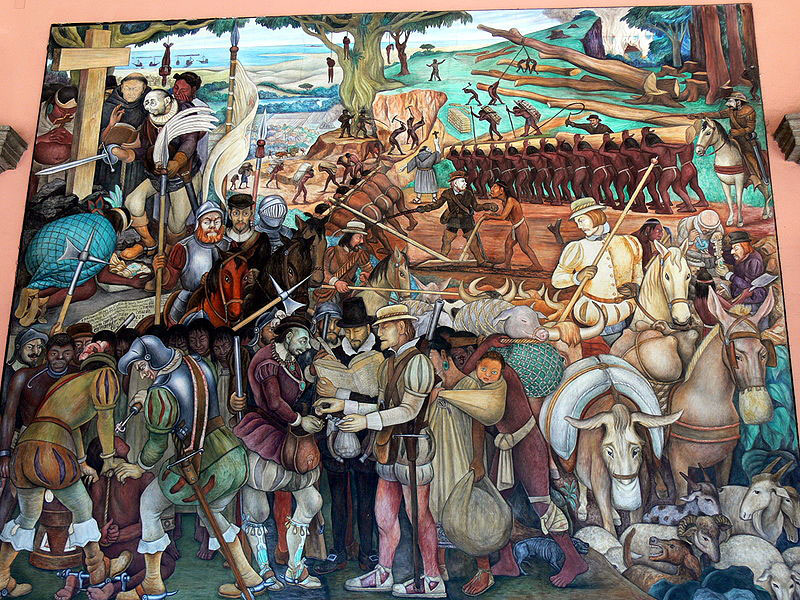A long and arduous search for something.
At the beginning 16th century, the gold was among the most desirable and sought-after goods with particularly ambivalent symbolic. The overseas quest for precious metals and its flow changed the face of Europe and contributed to its overall development. Tomas de Mercado, a Spanish scholar (1530-1576), wrote that Seville “used to be the end of the world and now is the very centre of it.” Seville grew into the monopolist harbour of that time due to organised fleets and tax control of the Casa de la Contratacion. The Spanish archives from XVII century had more written submissions then International Monetary Fond has nowadays. Increased amount of monetary-mint metal in circulation had stimulative effect on profit but caused the revolution of prices. The direct inflow of precious metal had given rise to prices and ruined Spanish economy. The indirect inflow of gold and silver in the continental Europe and England facilitated the outburst of trade, production and technological development.
Economist J.M.Kynes stated "when there is a gold, there is a civilisation", but historian P.Vilar added "when there is no gold, there is progress because the gold is sought-after". Greed-driven quest for mythic city El Dorado ("the golden one") made Francisco Orellana and Gonzalo Pizarro to take off for well known but tragic expedition towards the Amazon Basin (140 of the 220 Spaniards and 3,000 out of 4,000 natives had died along the way). El Dorado had never been found, but Orellana was remembered as the first person known to navigate and explore the whole length of the Amazon River.
Recommended artwork

enlarge image
History of Mexico, Fresco by Diego Rivera, 1929 - 1945, Palacio Nacional Mexico City
Photo: (cc) Wolfgang Sauber
A mural depicts Exploitation of Mexico by Spanish Conquistadors. The History of Mexico, commissioned in 1929, was divided into three sections: Prehispanic Mexico showing scenes of native culture before Spanish arrival, From the Conquest to the Present pictured the conquest of 1521, and Mexico of Today and of the Future celebrated Mexico’s fight for independence in 1810-21. Rivera’s frescoes combined influences of Aztec art, Maya’s steles storytelling, and Renaissance artists like Piero della Francesca.
An example in the ARTS -> “Bird Parliament”
Of Travel not of Days or Months, but Years--...
Life-long perhaps: of Dangers, Doubts, and Fears
As yet unheard of: Sweat of Blood and Brain
Interminable--often all in vain--
And, if successful, no Return again.
That in the Maidan of this World pursue...
The Golden Ball which, driven to the Goal,
Wins the World's Game but loses your own Soul.
This World's a Nest in which the Cockatrice
Is warm'd and hatcht of Vanity and Vice:
A false Bazaar whose Wares are all a lie,
Or never worth the Price at which you buy:
A many-headed Monster that, supplied The faster,
faster is unsatisfied.
REF -> an extracts from a poem Bird Parliament, also known as Conference of the Birds, a poem in Persian written by Farid ud-Din Attar, in 1177, tr. by Edward FitzGerald, in 1889.
The poem, an allegory of a Sufi doctrine, describes an arduous quest of birds for the mythical bird Simorgh. On their spiritual path to enlightenment the birds have to cross seven valleys: Talab (Yearning), Eshq (Love), Marifat (Gnosis), Istighnah (Detachment), Tawheed (Unity of God), Hayrat (Bewilderment), and Fuqur and Fana (Selflessness and Oblivion in God). Only thirty birds reached the land of Simorgh, but all they could see there was their reflection in a lake. In Persian "Si morgh" means "thirty birds", thus in Sufi interpretation it symbolises an idea of “God within” or mystical union with God reached through ascetic practice.
http://www.sacred-texts.com/isl/bp/bp01.htm